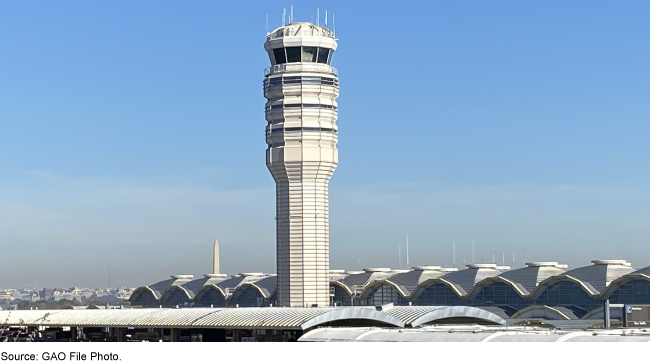Reagan National Airport: Information on Effects of Federal Statute Limiting Long-Distance Flights
Fast Facts
Long-distance flights use larger planes and carry more passengers, which can increase noise and airport congestion. At Washington, D.C.'s Reagan National Airport, most nonstop flights are limited by federal law to a range of 1,250 miles.
Exemptions have allowed flights to and from 10 cities beyond the limit, such as Denver and Seattle. While these flights may contribute to congestion at certain times, they haven't caused substantial delays.
We offer several factors for policymakers to weigh if they're considering adding more long-distance flights, including potential effects on airport congestion and airline competition.
Ronald Reagan Washington National Airport

Highlights
What GAO Found
Airlines serving Ronald Reagan Washington National Airport (Reagan National) are subject to, among other federal operational requirements, (1) a “perimeter rule,” limiting nonstop flights to a distance of 1,250 miles unless there is an exemption, and (2) a “slot” or operating authorization requirement for each takeoff and landing. GAO found that while the 40 daily beyond-perimeter flights to or from Reagan National accounted for about 6 percent of flights and 10 percent of passengers at the airport in 2019, the additional flights may have had some limited effects, including further reducing the airport's landside capacity (e.g., ticketing and gates). GAO's analysis of the Department of Transportation's (DOT) data from 2010 through 2019 showed that airlines used larger aircraft on beyond-perimeter flights carrying, on average, about 75 more passengers than within-perimeter flights. While these larger aircraft may use more capacity, they did not contribute to a substantial increase in flight delays at Reagan National. The beyond-perimeter flights may have also had other effects, such as drawing a few flights and passengers from Washington Dulles International Airport (Dulles).
2020 Beyond-Perimeter Flight Exemptions at Ronald Reagan Washington National Airport

Several factors—existing slot control rules; capacity at Reagan National; and potential effects on noise, other area airports, passengers, and airline competition—should be considered in any decision to modify Reagan National's perimeter rule, according to GAO's prior work and stakeholder interviews. GAO examined these factors under three scenarios: (1) no changes to the current perimeter rule or beyond-perimeter flights, (2) adding a small number of beyond-perimeter flights, and (3) completely lifting the perimeter rule. Many stakeholders who provided a perspective did not support changes to the perimeter rule, citing concerns about increased congestion at Reagan National or drawing passengers from other airports, primarily Dulles. Some stakeholders supported adding a small number of beyond-perimeter flights, citing increased competition if airlines added service to existing routes. No stakeholders supported lifting the perimeter rule, saying it would disadvantage airlines with a small number of flights at Reagan National. Regardless of their position on the rule, many stakeholders said airlines would add beyond-perimeter flights if allowed.
Why GAO Did This Study
Reagan National's perimeter and slot control rules were designed in part, respectively, to help increase use of Dulles and manage congestion at Reagan National by limiting the number of flights. On three occasions—2000, 2003, and 2012—federal statutes have provided exemptions to the perimeter rule, collectively allowing 40 daily beyond-perimeter flights (20 round trips) at Reagan National. Of these exemptions, 32 were new beyond-perimeter flights and eight allowed airlines to convert existing slots to beyond-perimeter flights. The Metropolitan Washington Airports Authority (MWAA) operates Reagan National and Dulles, and DOT and the Federal Aviation Administration (FAA) oversee these rules.
GAO was asked to update its past work on the perimeter rule. This report describes (1) the effects of beyond-perimeter flights at Reagan National, and (2) key considerations if additional beyond-perimeter flights are allowed. GAO analyzed DOT data for the most recent 10-year period (2010 through 2019) on passengers and flights at Reagan National and Dulles, and MWAA data on airport capacity at Reagan National in 2019. GAO also reviewed relevant statutes and regulations, and interviewed DOT and FAA officials, and a non-generalizable sample of 32 stakeholders: 9 airlines, 4 airport authorities, 7 academics, 5 associations, 5 community groups, and 2 consumer advocates. Selected airlines included those that operate out of Reagan National or Dulles; other stakeholders were recommended or selected, in part, from prior GAO work and their expertise on the topic.
For more information, contact Heather Krause at (202) 512-2834 or krauseh@gao.gov.
